Your Primer to the Psychology of Marketing: The Science of Emotional Buying and What Marketers Can Do About It

A few weeks ago while working from home, I heard a knock on my front door. I thought it was the postman, as he typically drops our mail off at that specific hour in the morning.
Much to my surprise, a man wearing what looked like a company branded polo shirt introduced himself saying that he was visiting our neighborhood as a ‘hawker.’ Before he showed me any of his wares, he said he’d like to show me his ID card and tell me a bit about himself.
He pulled out his ID, which was hanging around his neck, said his name was Ben, and explained that earlier on in his life he had been involved in ‘silly activities,’ hung around in bad company and eventually got into trouble. He further explained that, upon his release from prison, he got this job as a door-to-door salesman in order to have some work experience under his belt and eventually get a real job.
He said that he was part of a not-for-profit helping ex-convicts get back on their feet and that he would take home 50% of any sales he makes.
His narrative spoke directly to my emotions and I was sold before he actually pitched any products to me. He had a bag full of household cleaning products we probably already had. I hastily selected a duster and carpet cleaner, asked for the price and paid $10 for them. He was really appreciative and I felt I had made an impact in his life and would hopefully contribute to keeping him away from trouble.
On reflection, he captured the attention of my emotions first, before pitching his products. Although his story reflected his reality, this was geniusly executed neuro-marketing.
Imagine if he left out his backstory and just said, “Good morning mate! I’m Ben and I have these household cleaning products to sell to you today all under $10!” My response would most likely have been, “Thanks but, no thanks!”
Decisions are Emotional, Not Rational
In 1994, a neuroscience professor by the name of Antonio Damasio published a book titled, Descartes’ Error: Emotion, Reason and the Human Brain; where he went through a series of case studies that demonstrated the importance of emotions to rational thinking and normal social behavior.
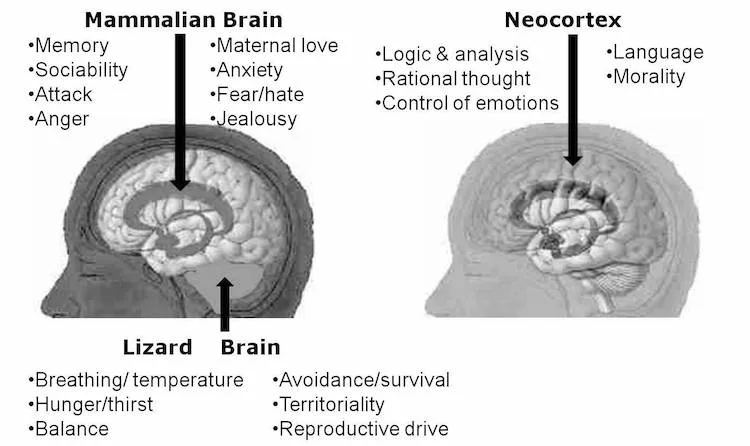
His groundbreaking discovery shifted the focus of modern neuroscience and the advertising industry from the rational and cognitive aspects of brain function to the emotional.
Damasio studied people with damaged brains incapable of processing emotions. He found that their lack of emotions hindered their ability to make decisions. They could rationalize and describe their decisions in rational and logical terms but found it difficult making simple decisions because they lacked any sense of how they felt about the options presented to them.
Damasio actually wrote:
“I never wished to set emotion against reason, but rather to see emotion as at least assisting reason…nor did I ever oppose emotion to cognition since I view emotion as delivering cognitive information.”
What Neuroscience Tells us About Emotions and Logic

Our brains have two main parts: the limbic system (or core) and the neocortex (outer brain).
The core is divided into what neuroscientists refer to as our ‘reptilian brain’ and our ‘mammalian brain.’
The reptilian brain is responsible for survival reflexes such as hunger, breathing and other bodily functions. While the mammalian brain handles emotions or feelings.
The limbic system views the environment in black and white; it generally processes information and makes decisions somewhat automatically and quickly as compared to the neocortex –– which is the huge grey bit that you probably imagine when you think about a brain. The neocortex is the part of our brain that makes us intelligent, processes language, logic, decisions and control of emotions.
In evolutionary terms, the neocortex is a much more recent in development, and it is actually bigger in humans than in other animals.
For example, if you suddenly hear a loud bang, your limbic system (or core) will instinctively crave for safety and will tell you to be afraid. Your neocortex will, however, analyze and rationalize the context of the situation and make the final call as to whether it is harmless ‘thunder,’ if it was raining, or if we should run away as a result of an explosion.
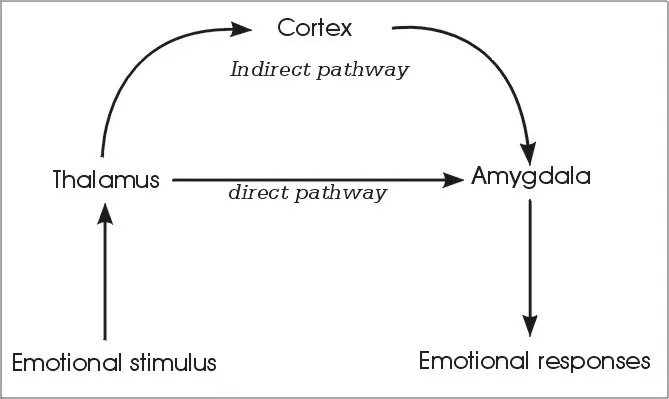
Source: OECD
In day-to-day life, whenever you are confronted with an external emotional stimulus such as love, anger or fear, it is typically routed through the neocortex first (for rationalizing and analysis) before being sent to the amygdala –– a part of the limbic system responsible for providing appropriate emotional responses.
This is how things should work in theory, but because the neocortex is a newer and less mature area of the brain in evolutionary terms, it is less efficient than the limbic system (the core).
This means that emotional stimuli sometimes ‘short circuits’ or bypasses the neocortex (any logical analysis) and, as a result, emotional responses are automatically triggered. This is a typical occurrence in all brains, but occurs more frequently in some people than others.
To put this in context, this explains sudden bursts of road rage and phobias of spiders, where the brain is unable to process rational thought.
An arachnophobe, for example, is unable to process that a spider is harmless, not poisonous and that humans are more than 1,000x bigger. Therefore, it logically poses no threat and there is no need to be afraid of it.
How to Speak Directly to Emotions: The Limbic System
When an individual is emotionally attached to a point of view, using only logic as means of persuading the individual to change his or her opinion is not very effective. His or her emotionally grounded views will trigger defensive behavior because their emotions will see this as an ‘attack’ that warrants short-circuiting the route via the cortex. The person’s response would be an emotional response with no rational analysis from the cortex.
What Marketers Need to Know: Motivation Emotions v. Critical Emotions
First, you need to accept that you cannot prevent the market and your customers from having negative or positive emotional reactions. With this acceptance, you will need to understand the motivational emotions and critical emotions that might trigger outright rejection of your offer or product.
Motivation emotions that drive buying behavior tend to be driven by the following five core emotions:
Fear
Guilt
Pride
Greed
Love
According to Dan S. Kennedy in his book No B.S. Marketing to the Affluent, each of these motivation emotions translate into more specific emotions for the affluent marketing segment looking to buy more luxurious products.
Take, for example, the emotional drivers for wanting to buy a high-end car such as a Ferrari. They could translate to the following:
insecurity within new social status
reward for workload or societal status
fear of being found to be fakers
desperate desire not to commit a faux pas
wanting to be “today, not passé”
feeding their emotional emptiness
what’s the point of being rich? Buy it!
Other more granular motivational emotions for mass market products still grounded in the five core emotions above are:
Competition: “Our neighbors have that grill, so we need to get it or something better.”
A sense of belonging: “I’ll join my friends and get that Apple watch.”
Trendsetting: “My favorite celebrities own a hoover board, I need to get one!”
Instant gratification: “I’m feeling down, something new will make me feel better!”
Leadership: “I’ll be the first person in the office to get that phone.”
Time: “This subscription saves me time of having to go shopping.”
Your ammunition as a marketer is the understanding of the specific motivational emotions that will entice your target customers to buy your products and their critical emotions that will deter them from buying your products.
You will need need to develop accurate customer personas and then craft an emotionally driven narrative that speaks to both their motivational and critical emotions and achieves your objective to sell.
How do you do this?
Language is key
Aim to use the following in your copywriting and video scripts:
Metaphors
Storytelling that amplifies human feelings
Painting visual images
Endorsements and social proof
Empathy that aligns with the point of view of customers
The end objective of the design, the color selection and messaging on your packaging and in your entire marketing communications is to become a likable brand which will result in a positive memory recall of your website or brand name by your audience.
Here are ways of changing rational words to emotional ones in your narrative:
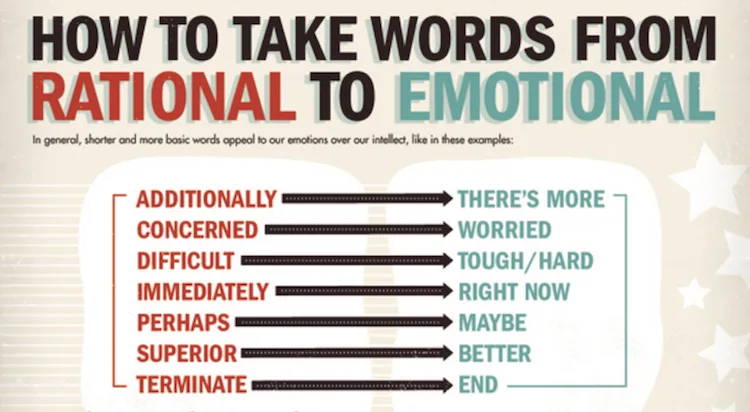
Source: Cox Blue
The Role of Emotions and Logic in Consumer Behavior
When presented with a range of choices at the point of making a purchase decision, the average consumer seems to think that his or her purchase decision is guided by rational analysis.
The reality however is that emotions play a predominant role in majority of purchase outcomes. Emotions tap into previous and related experiences that seem to attribute subjective values to each option under consideration.These subjective values translate to preferences that lead to our final decision.
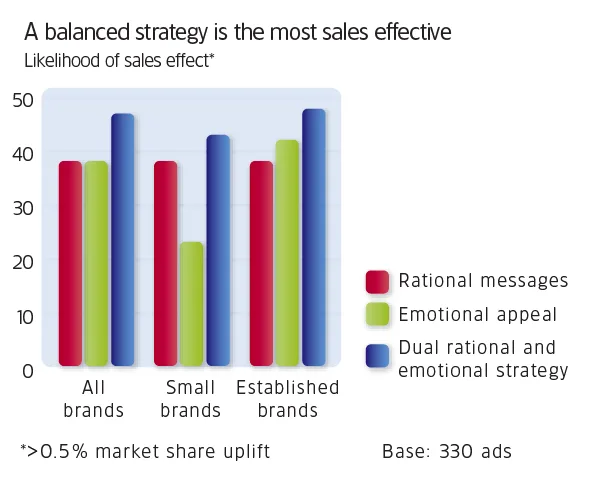
Source: WPP & Millward Brown Knowledge Bank
Emotions play a central role in consumer behavior; our buying decisions seem to be driven by emotions and then justified with logic.
Key Emotional Drivers that Influence Buying Decisions
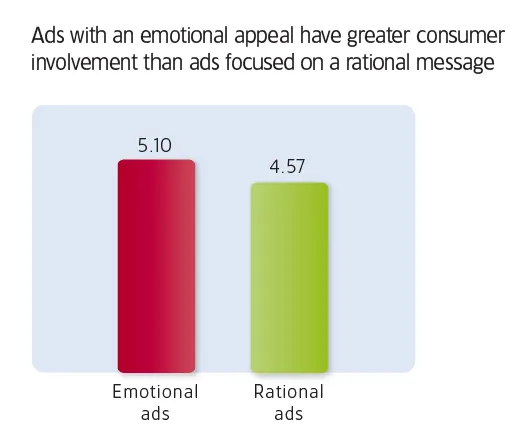
Source: WPP
Research into the most effective of advertisements reveals that consumers are most influenced by emotional ads in comparison to rational ads focused on features.
Advertising and marketing copy that generates a strong emotional response has two benefits.
First, it helps personify a brand and actually shape brand perception
Second, the effect of personifying a brand helps generate engagement and memorability
Your marketing copy could also take the route of a hero narrative; where negative emotions such as sadness, fear or guilt are initially generated to help create drama, which ultimately result in a positive emotional takeout.
As a product developer, retail or ecommerce marketer looking to influence the buying decisions of potential customers through emotions, you really need to focus your core marketing strategy on optimizing the following three areas in your packaging, visual imagery, brand narrative and marketing copy used to describe your brand or sell products.
Likability: Creating a genuinely likable brand
Key emotional triggers: Utilizing the most relevant emotional drivers (negative and positive) in your messaging
Reinforcing positive brand memories, and ultimately earning industry mindshare
I will breakdown each of the above in the rest of this article.
1. Likeability
Likeability is a key driver of advertising’s effectiveness. Likability is the one core metric your marketing messaging should strive to optimize. Here’s why.
Research conducted by America’s Advertising Research Foundation concluded that consumers driven by the emotion of ‘likeability’ were most likely to respond to a brand’s ad by eventually buying the product.
Likeability outperformed 34 other commercial “pre-testing” methodologies as a predictive metric for sales from advertising.
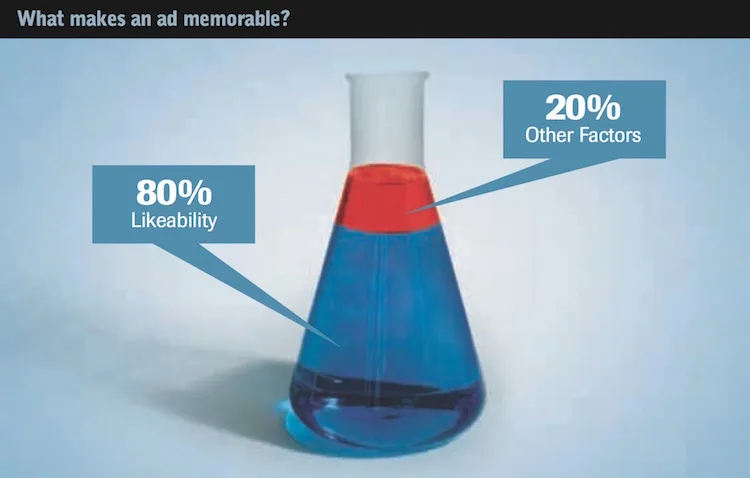
Source: 5MetaCom
Another study in 2005 by Hermie, Lanckriet, Lansloot and Peeters, titled “Stop/Watch: Everything you need to know about the impact of magazine ads,” found that up to 80% of an ad’s memorability is tied to its likeability.
In the book “Advertising and the Mind of the Consumer: What Works, What Doesn’t, and Why”, written by Max Sutherland and Alice Sylvester, their research was able to bridge a positive link between likeability and persuasion.
It is little wonder Facebook’s first social reaction was the ‘like’ button.
Other studies have gone on to show that positive emotions toward a brand has far greater influence on consumer loyalty than trust and other brand attributes.
Improving Likeability with the COMMAP Model
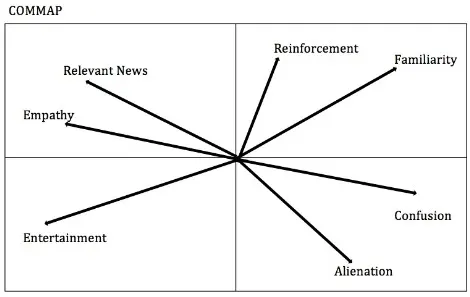
In the advertising world, Erik du Plessis, in his book The Advertised Mind, devised a model for creating more likeable ads called COMMAP – COMmunication-style MAP, that breaks the likeability of an ad down to six elements.
Entertainment: If the ad entertains, it will be liked — although entertainment is not restricted to just the use of humor.
Empathy: People like ads they can relate to — ads that show the kind of goods they may possess, experiences they might have or lifestyles they may aspire to.
Relevant news: More than just new information, relevant news is new information that is meaningful (or presented as such) to the audience. Problem-solution type advertising falls into this category.
Familiarity: If an ad has been over-saturated in the market, or is run-of-the-mill, it can have the opposite effect of entertainment — and damage likeability.
Confusion: This is the most common mistake creatives make in designing advertising. A confusing ad can’t deliver relevant news, entertain or create empathy.
Alienation: Irritating the audience is a sure way to alienate consumers. While advertising that is confusing can be ignored, advertising that is annoying can actually damage a brand.
It is important to note that the first three, relevant information combined with empathy and entertainment, are things that we should strive for.
Familiarity, confusion, and alienation, are three things that we should reduce.
Emotional Oriented Marketing for Likeability
Examples of emotional-oriented marketing optimized for likability include the following.
Share a Coke Campaign

The Share a Coke campaign printed the most popular names in each geographical marketing region in which Coca Cola operated on bottles of the product. The campaign combined the elements of entertainment (seeing my name on bottle of coke), empathy (my name is as personal as it gets) and relevant news (this was a novelle marketing campaign not attempted at this scale by other brands).
Herschel Supply Co Well Travelled Campaign
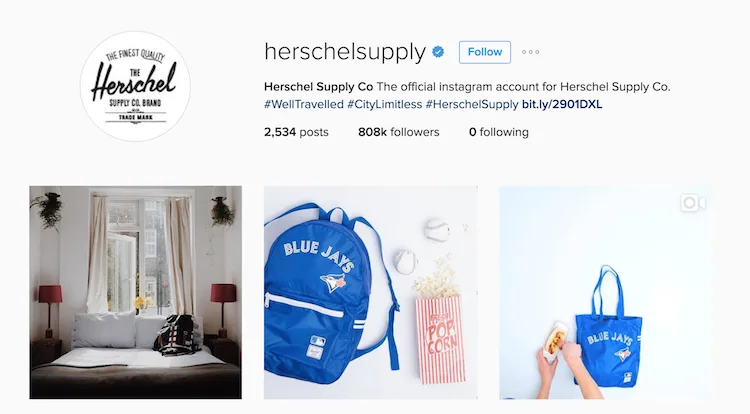
The Well Travelled photo blog and the #WellTravelled instagram hashtag utilized by Herschel Supply Co have personified the brand as a wandering world traveller.
This campaign also combines the elements of entertainment (seeing interesting travel destinations), empathy (these destinations appeal to Herschel Supply Co’s target customers) and relevant news (the content is relevant and meaningful to their audience).
McDonald’s Happy Meal Toys

McDonald’s used to use toys in their Happy Meal commercials to lure children to come to their restaurants. It combined the elements of entertainment (by including interesting kids toys), empathy (knowing that toys make kids happy and if kids are happy, their parents are also equally happy) and relevant news (most toys were in season and related to a recent, popular kid’s movie release).
Ways of Evoking Likeability and Positive Emotions
Your marketing copy and even product design (if you sell products), should aim to incorporate the following in a bid to maximize likeability and positive emotions:
Storytelling
Painting visual images
Advertising
Endorsements
Metaphors and Similes
Humor
The goal is to not have buyers to think too hard before pushing ‘Buy.’ Perks such as free shipping and free returns should also be incorporated into your ecommerce strategy in order to sweeten the conversion deal.
2: Key emotional triggers
For retail and ecommerce marketers, your marketing and product messaging should utilize emotional triggers that connect to your customers’ buying decisions.
Here are 10 key emotional drivers of buying behavior:
Fear (negative)
Guilt (negative)
Trust (positive)
Value (positive)
Belonging (positive)
Competition (negative)
Instant gratification (positive)
Leadership (positive)
Trendsetting (positive)
Time (positive)
Narratives that initially generate negative emotions need to ultimately result in a positive emotional takeout.
3: Building and Reinforcing Positive Brand Memories
A growing body of academic research is proving that the majority of customer purchases are at least partially memory-based.
In the context of marketing your ecommerce brand or product, it is paramount to create and reinforce positive brand memories and associations that directly allow customers to recall your brand and buy your product when they are in a position to make a purchase or shop in your store. The stronger your brand and product memories are over your competition, the more sales you’ll see.
The following four steps approach as devised by Percolate will optimize your marketing for memory and mindshare:
Understand the mechanics of consumer memory: What makes a brand distinct and memorable?
Perform a ‘memory audit’ of your brand: What elements and associations are memory strengths? What are weaknesses? What’s the competitive landscape, and how is your current market share (and share of voice) influencing memory rank?
Strengthen your brand anchors: What are the key brand elements and associations that provide a foundation for scalable, consistent campaigns to build brand memory?
Develop a communications system: How do you organize an operating architecture to develop and deploy messages that reinforce the brand?
The following seven questions, also devised by Percolate, should be asked to assess your brand memory-building strategy:
Top-level global questions:
Big Story: Does your brand have a single global story, mission or theme that is consistent across all communications?
Identity System (tone of voice): Does your brand have a distinct verbal and visual system that is represented and repeated across all communications?
Tactical execution questions:
Consistency: Do campaigns and each of their communication elements reinforce the same brand system?
Clarity: Can your customers associate your communications with your brand?
Impact: What retrieval cues are these campaign communications delivering, and are they being delivered through the most emotionally engaging form(s) of media available?
Reach: Where and in how many different places will your brand’s target audience be exposed to these communications?
Frequency: How often will the target audience be exposed to these communications?
Your communications and advertising campaigns should all converge to effective capture not only positive attention but also build memory.
Conclusion
I will conclude by saying that a brand is nothing more than a mental representation of a product in the consumer’s mind.
Emotions are the primary reason consumers prefer a brand name or shop with a retailer over another. After all, many products we purchase are available as generic brands with the same ingredients and at cheaper prices. Emotional connections rationalize our decisions to pay more for a brand name product over another somewhat identical product.
If the representation consists only of the features and attribute, no emotional connection establishes a link to influence consumer preference and action.
The richer the emotional content of a brand’s mental representation –– as exemplified by the words used to describe the brand, its personality characteristics in packaging/visual imagery and the brand ‘narrative’ –– the more likely a consumer will buy the product.

Kunle is a trusted advisor to ambitious, agile ecommerce brands. His core strengths lies in growing revenue by developing and executing scalable customer acquisition and search marketing strategies for online retailers. He blogs, runs webinars and teach courses about ecommerce growth on 2XeCommerce.com. He also hosts an ecommerce podcast dedicated to growing and scaling online retail businesses.


